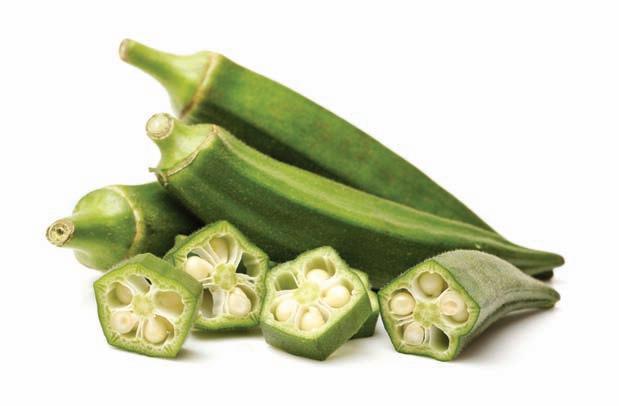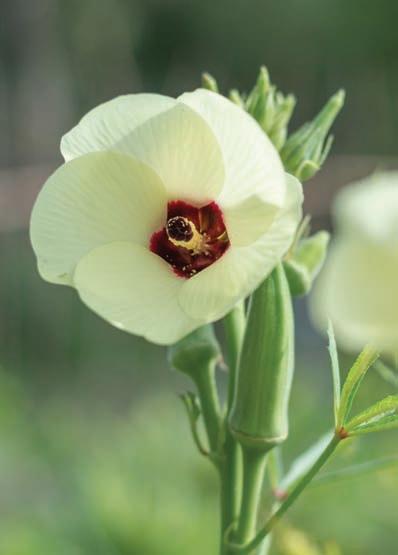
3 minute read
OKRA
When I think of growing okra, I think of my Dad’s vegetable garden years ago. If it didn’t get moisture from above, it did without. By the time the dog days of summer came around, everything was scorched except the okra. I remember picking a lot of okra on hot afternoons and then enjoying Momma’s golden fried okra later in the day. Okra was the humble workhorse in the garden.
Then a few years ago, I attended a garden party in an exclusive area of Dallas. There in the middle of immaculate flower beds were stately stalks of okra with their beautiful yellow and white Hibiscus-like flowers complimenting the other perennials and roses. I gained a new appreciation for okra and my flower gardens have rarely been without it since that time.
Advertisement
We live in the right place to grow okra! It’s very easy to grow, tastes good, is rich in Vitamin A, and even compliments the ornamental garden. If planted by the first week of August, you might even get a good Fall crop. It’s important to keep in mind that it takes at least 60 days for okra to mature and okra loves the hot weather.
Okra is a member of the mallow family, botanical name Abelmoschus esculentus. As a relative of the Hibiscus, okra has a beautiful soft yellow or white bloom that will produce an okra pod in about four days after blooming. Be sure to harvest okra as soon as it is two to three inches long, while it is still tender, otherwise it will become too tough to use.
A BEAUTIFUL WORKHORSE IN THE LANDSCAPE OKRA,
BY SUSAN KNAPP, 2018-19 ECMGA PRESIDENT
VARIETIES My personal favorite varieties are Cowhorn (Southern Acclimated) and Burgundy (Southern Acclimated). I buy these from one of my favorite seed sellers – Brim Seed, who also happens to be one of our EXPO Vendors. The Burgundy is an especially beautiful edible landscape plant. Clemson Spineless and Emerald Velvet are two other recommended varieties.

PLANTING Like all vegetables, okra needs to be planted in fertile soil that has been amended with compost. Okra is not as particular as some of the other vegetables that require heavy feeding, but it will do much better and produce better in fertile soil. A side dressing of 10-10-10- fertilizer, compost or manure is suggested when planting. I always plant okra by direct seeding rather than buy plants at the nursery. It’s much more cost effective and okra has a tap root that must remain intact when planting, If damaged the plant will not survive. When planting okra in the Spring be sure the soil has warmed to at least 65, but preferably 75 degrees. Okra loves the heat. Thin the plants and leave 1 to 2 feet between plants; with 3 to 4 feet between rows. CARE Okra is easy to care for. Eliminate weeds when plants are young and mulch well. In spite of what my Dad did, okra needs an inch of water every 7 to 10 days. After the first harvest, pull the lower leaves from the plant and that will improve production.
HARVEST Finally, about 60 days after planting you will be harvesting your first okra. Use a sharp knife and wear skin protection when harvesting. Cut just above the cap and when the pod is still young and tender. There are many ways to prepare okra.


BUILDING WITH LOVE $1.5 MILLION CAPITAL PROJECT JOIN US IN OUR
PHASE I
• Complete! PHASE II
• Replicate the Distribution Facility in Ellis County using the sustainable model in Johnson County with the addition of office space for staff
• Ensure the same level of quality and delivery throughout our service area PHASE III
• Build a modest office building for staff on the site of the Distribution Facility in Johnson County
• Provide much-needed office space for staff

SHOW YOUR LOVE & SUPPORT BY INVESTING IN OUR FUTURE...TODAY WHO YOU’RE HELPING...



THE FOOD YOU’RE PROVIDING...
ELLIS COUNTY 1311 Ferris Ave Ste C Waxahachie, TX 75165 888.8MY.MEAL
JOHNSON COUNTY 106 E Kilpatrick St Cleburne, TX 76031 888.8MY.MEAL


NAVARRO COUNTY 108 S Beaton St Ste H Corsicana, TX 75110 888.8MY.MEAL










